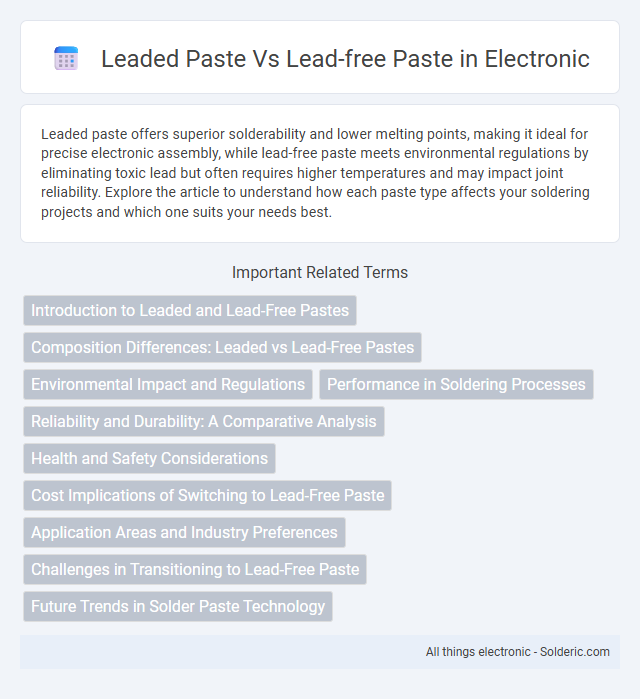Leaded paste offers superior solderability and lower melting points, making it ideal for precise electronic assembly, while lead-free paste meets environmental regulations by eliminating toxic lead but often requires higher temperatures and may impact joint reliability. Explore the article to understand how each paste type affects your soldering projects and which one suits your needs best.
Comparison Table
| Feature | Leaded Paste | Lead-Free Paste |
|---|---|---|
| Composition | Contains lead-tin alloy (e.g., Sn63Pb37) | Contains tin, silver, copper (e.g., SAC305) |
| Melting Point | Lower (~183degC) | Higher (~217-220degC) |
| Solder Joint Reliability | Excellent wetting, less brittle | Good wetting, slightly more brittle |
| Environmental Impact | Contains toxic lead, hazardous | Lead-free, RoHS compliant, eco-friendly |
| Cost | Generally lower cost | Higher cost due to silver content |
| Regulatory Compliance | Restricted in many regions (RoHS, WEEE) | Compliant with global environmental standards |
| Assembly Temperature | Lower reflow temperature required | Higher reflow temperature required |
| Usage | Legacy electronics, special applications | Modern electronics, mass production |
Introduction to Leaded and Lead-Free Pastes
Leaded paste contains tin, lead, and other metals, offering excellent wetting properties and a lower melting point ideal for traditional soldering in electronics manufacturing. Lead-free paste, composed mainly of tin, silver, and copper, meets environmental regulations and reduces health hazards while requiring higher temperatures during soldering. Your choice between leaded and lead-free paste impacts solder joint reliability and compliance with industry standards such as RoHS (Restriction of Hazardous Substances).
Composition Differences: Leaded vs Lead-Free Pastes
Leaded paste contains a combination of tin, lead, and silver, providing lower melting points and excellent wetting properties, which ensures reliable solder joints. Lead-free paste typically uses alloys such as tin, silver, and copper (SAC), aiming to comply with environmental regulations like RoHS while maintaining high melting points and good mechanical strength. Understanding these composition differences helps you select the appropriate solder paste for durability and regulatory compliance in electronic assembly.
Environmental Impact and Regulations
Leaded paste contains toxic lead compounds that pose significant environmental hazards due to soil and water contamination during manufacturing and disposal processes. Lead-free paste, mandated by regulations such as RoHS (Restriction of Hazardous Substances), reduces hazardous waste and complies with global environmental standards to promote safer electronic assembly. Your choice to use lead-free paste supports sustainability efforts and ensures compliance with stringent environmental regulations, minimizing ecological damage.
Performance in Soldering Processes
Leaded paste offers superior wetting properties and lower melting temperatures, resulting in more reliable solder joints and reduced risk of thermal damage during soldering processes. Lead-free paste, typically based on tin-silver-copper (SAC) alloys, requires higher reflow temperatures, which can increase thermal stress and affect component lifespan. Despite environmental benefits, lead-free soldering demands precise process control to match the consistent joint quality provided by leaded pastes in electronics manufacturing.
Reliability and Durability: A Comparative Analysis
Leaded paste exhibits superior wetting properties and stronger solder joints, contributing to enhanced reliability and durability in electronic assemblies under thermal cycling and mechanical stress. Lead-free paste, primarily composed of tin, silver, and copper, often faces challenges such as increased brittleness and susceptibility to joint fatigue, impacting long-term performance. Advances in lead-free formulations aim to close the reliability gap, but leaded solder remains the benchmark in high-reliability applications due to its proven joint integrity and extended lifespan.
Health and Safety Considerations
Leaded paste contains toxic lead, posing significant health risks including neurological damage and reproductive harm, necessitating strict handling and disposal regulations. Lead-free paste, often composed of tin, silver, and copper, presents a safer alternative by reducing hazardous exposure during manufacturing and soldering processes. Workplace environments using lead-free paste benefit from improved air quality and compliance with stringent environmental and safety standards such as RoHS.
Cost Implications of Switching to Lead-Free Paste
Switching to lead-free paste often results in higher material and processing costs due to the need for specialized equipment and stricter quality control measures. Lead-free solders typically require higher reflow temperatures, increasing energy consumption and reducing equipment lifespan. Despite increased upfront expenses, regulatory compliance and environmental benefits justify the investment for manufacturers aiming to avoid lead-related liabilities.
Application Areas and Industry Preferences
Leaded paste remains favored in electronics manufacturing for applications requiring excellent solderability and reliability, especially in aerospace and military sectors where stringent performance standards prevail. Lead-free paste is increasingly adopted in consumer electronics and automotive industries to comply with environmental regulations like RoHS, prioritizing sustainability without compromising joint integrity. Your choice between these pastes should consider industry-specific requirements, product lifecycle, and regulatory compliance to ensure optimal manufacturing outcomes.
Challenges in Transitioning to Lead-Free Paste
Transitioning to lead-free paste presents significant challenges including higher melting points, which require modified soldering processes and equipment adjustments to avoid thermal damage to components. Reliability concerns arise due to increased brittleness and susceptibility to joint fatigue in lead-free solders compared to traditional leaded paste. Your manufacturing line may also face compatibility issues and stricter quality control demands to maintain product performance and meet environmental regulations.
Future Trends in Solder Paste Technology
Lead-free paste dominates future trends due to environmental regulations and health concerns, driven by initiatives like RoHS and WEEE directives shaping global manufacturing standards. Innovations focus on enhancing lead-free solder paste formulations to match leaded paste's performance in thermal fatigue resistance and bond reliability through advanced alloys such as SAC305 and novel flux chemistries. Industry research prioritizes improved wetting properties and reduced voiding while minimizing solder paste volume, enabling finer pitch applications essential for evolving electronics miniaturization.
leaded paste vs lead-free paste Infographic

 solderic.com
solderic.com